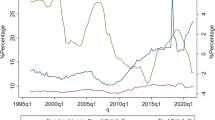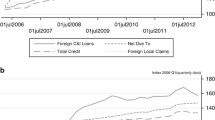Abstract
Banks accept deposits and often lend via commitments. It has been shown that there are synergies between transaction deposits and loan commitments; and that the volatility of bank stock returns declines when these two liquidity risks are taken together. We examine whether such deposit-lending synergies reflect on U.S. commercial bank profitability levels, and whether the synergies impact bank profitability levels differently around financial crises. Our results from panel regressions show that the deposit-lending synergies translate to increased profitability only for small publicly traded banks. However, pre-crisis deposit-lending synergies do not appear to lead to higher profitability during or after the crises.


Similar content being viewed by others
Notes
Off-balance sheet activities: https://www.fdic.gov/regulations/safety/manual/section3-8.pdf
Call reports are available at https://www.chicagofed.org/banking/financial-institution-rBeginning Maeports/commercial-bank-data
Beginning on March 31, 2011, the banks’ call reports are available from the FFIEC Central Data Repository’s Public Data Distribution at https://cdr.ffiec.gov/public/
Monthly federal funds rates are available on the website of the Board of Governors of the Federal Reserve System at http://www.federalreserve.gov
Employment data are from the website of the Bureau of Labor Statistics at http://www.bls.gov
As Holod and Peek (2007) suggest, scaling by assets allows a clearer interpretation of relative responses to changes.
Including or excluding unused credit card commitments lead to similar results in our study.
We reduce to 5 quarters the post-crisis period of the Russian debt /LCTM bailout crisis, as well as the pre-crisis period of the bursting of the dot.com bubble crisis to insure that these periods are not contaminated by crisis proximity.
References
Akhigbe A, McNulty J (2005) Profit efficiency sources and differences among small and large U.S. commercial banks. J Econ Finan 29(3):289–299
Avery R, Berger A (1991) Loan commitments and bank risk exposure. J Bank Financ 15:173–192
Berger AN, Bouwman CHS (2008) Financial crises and bank liquidity creation (This is an OLD WP that has been split into 2 parts: (1) How does capital affect bank performance during financial crises (JFE, July 2013); and (2) Bank liquidity creation, monetary policy, and financial crises (WP 2012)). https://doi.org/10.2139/ssrn.1231562. Accessed 3 Jan 2016
Berger AN, Miller NH, Petersen MA, Rajan RG, Stein JC (2005) Does function follow organizational form? Evidence from the lending practices of large and small banks. J Econ Finan 76(2):237–269
Bernanke BS, Lown CS (1991) The credit crunch. Brook Pap Econ Act 2:205–248
Billett MT, Flannery MJ, Garfinkel JA (1995) The effect of lender identity on a borrowing firm’s equity return. J Financ 50:699–718
Boot AWA, Greenbaum SI, Thakor AV (1993) Reputation and discretion in financial contracting. Am Econ Rev 83:1165–1183
Dell’Ariccia G, Detragiache E, Rajan RG (2008) The real effects of bank crises. J Financ Intermed 17:89–112
Diamond DW, Dybvig PH (1983) Bank runs, deposit insurance, and liquidity. J Polit Econ 91(3):401–419
Gatev E, Strahan PE (2006) Banks’ advantage in hedging liquidity risk: theory and evidence from the commercial paper market. J Financ 61:867–892
Gatev E, Schuermann T, Strahan PE (2009) Managing bank liquidity risk: how deposit-loan synergies vary with market conditions. Rev Fin Stud 22(3):995–1020
Hancock D, Laing AJ, Wilcox JA (1995) Bank balance sheet shocks and aggregate shocks: their dynamic effects on bank capital and lending. J Bank Financ 19:661–677
Holmström B, Tirole J (1998) Public and private supply of liquidity. J Polit Econ 106(1):1–40
Holod D, Peek J (2007) Asymmetric information and liquidity constraints: a new test. J Bank Financ 31:2425–2451
Kashyap AK, Rajan RG, Stein JC (2002) Banks as liquidity providers: an explanation for the coexistence of lending and deposit-taking. J Financ 57(1):33–73
Myers SC, Rajan RG (1998) The paradox of liquidity. Q Rev Econ Financ 113(3):733–777
Peek J, Rosengren ES (1995) The capital crunch: neither a borrower nor a lender be. J Money Credit Bank 27(3):625–638
Thakor AV (1996) Capital requirements, monetary policy, and aggregate bank lending: theory and empirical evidence. J Financ 51:279–324
Author information
Authors and Affiliations
Corresponding author
Rights and permissions
About this article
Cite this article
Arthur, B.R., Rabarison, M.K. Deposit-lending synergies and bank profitability. J Econ Finan 42, 710–726 (2018). https://doi.org/10.1007/s12197-017-9414-x
Published:
Issue Date:
DOI: https://doi.org/10.1007/s12197-017-9414-x




